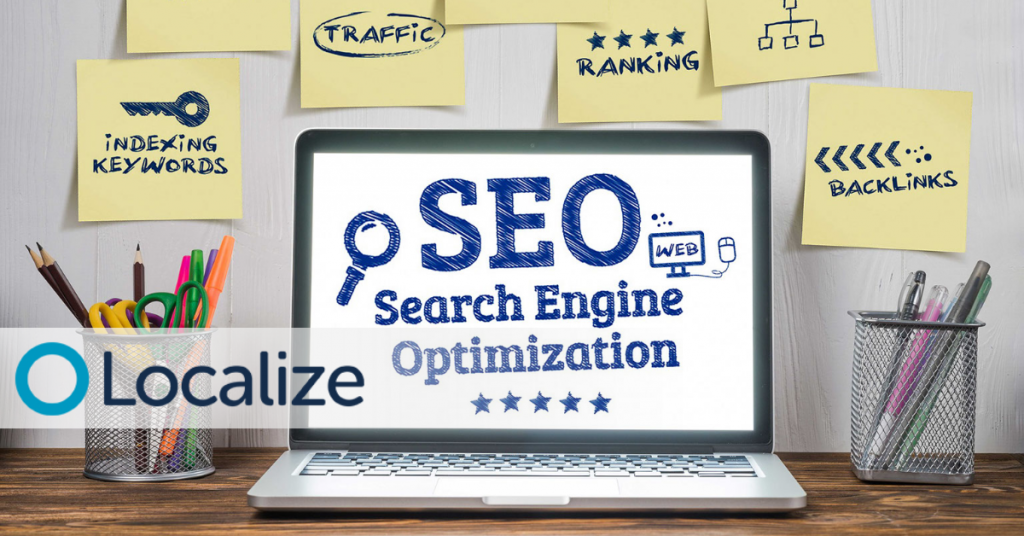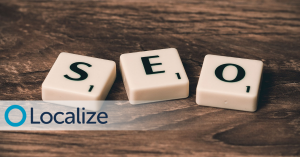You might be managing your website localization really well, but are you paying attention to localizing your SEO? If you have just rolled out a different language version of your website without also taking care of local SEO, you are shooting yourself in the foot. Not considering local keywords and backlinks will cost you valuable site visitors. You’ve invested a considerable amount of your marketing budget to reach out to a new audience, but if they don’t get their eyes on your website, all your efforts will have been in vain.
- There are almost 2 billion websites worldwide, and you are up against local competition that understands your target market better than you do. Plus, big international companies are competing on your keywords.
Can’t Read, Won’t Buy
Over 60 percent of native speakers never or rarely buy from English-only websites. You probably already know that you should be localizing, but you also need to get foreign visitors to land—and remain—on your site. So, just making your content available in a different language isn’t enough. You have to do more.
Enhance User Experience
The first step in mastering local SEO is mastering the user experience (UX). Pay attention to the many details in each country you localize for, including:
- Making sure that the currency is displayed in the right unit.
- Using metric for time formats, dates, weights, and various other measurements. (There are only three countries that don’t use the metric system – the United States, Myanmar, and Liberia.)
- Taking into account metrics like time spent on the page and “site stickiness.” If visitors are arriving but not hanging around, your local SERP will go lower, and with it your visitors.
Ensuring that your visitors have an optimum user experience will have a positive effect on your localized SEO. When visitors receive a good impression of your site, they’ll tend to share it, bookmark it, return to it, and link to it. All this behavior will aid your local SEO.
New Country—New Rules
One major error you might make with local SEO is to assume that the same rules apply to every language. For instance, consider the differences between an English speaker from the UK and one from the US. For example, Brits go on holiday and Americans take vacations.
If using the same keywords in the US and the UK can backfire, why should things be any different when it comes to Spanish spoken in Spain and Spanish spoken in Colombia? Or French in France and French in North Africa?
The success of your localization project depends on your use of the right keywords.
On-Page Optimization for Local SEO
Your choice of keywords is the key to successful on-page optimization for localized SEO. Put simply, you need to know what people in your target audience are searching for.
Here’s a newsflash for you – choosing the right keywords isn’t necessarily a job for your translator. The target language may come naturally to them, but they may not completely understand the nature of your business. Translators may have no experience of searching for your particular product or service and may only guess at the relevant terms to use.
Your localized SEO will significantly benefit if you include expert local marketing consultation and advice. At a minimum, survey some customers in your targeted region and also check out the keywords your competition is bidding on.
If you don’t get your keywords right, you won’t get noticed, period.
Localized Landing Pages
Be sure to avoid a user clicking for more info and landing on a page in another language. This will only lead to frustration for your visitor, who will probably abandon your site.
Make sure that your produce/service and quote pages are covered to boost localized SEO.
Localize your content well, taking into account local speech patterns, holidays, beliefs, and buying preferences. (Germans, for example, don’t like paying with credit cards.)
Other Things to Consider for Local SEO
If you’re serious about gaining a foothold in a new country and making more sales, be serious about doing it right. This means considering the following:
URL Structure
Different languages take up different amounts of space. So, when localizing your pages into another language, check the URL structure. Keep your content short with relevant keywords.
Metadata
Your nicely optimized meta titles may become longer and clumsy when translated into another language. Check all of your meta titles for the following:
- Are they under 70 characters, including spaces?
- Is the keyword at the front, and is it relevant to the page?
- Are your descriptions unique, with 156 characters or less?
- Avoid repetition in your page metadata, or you’ll run the danger of keyword cannibalization.
Headers
Use H1 for titles and H2 and H3 for sub-headings. Be certain to break your text up under several headers so your visitors aren’t faced with an impenetrable wall of words.
Images
Where necessary, replace your site images with ones that are more culturally appropriate. Keep in mind that heavy images will slow down your site. (When working with different internet speeds around the world, site speed is crucial.) Be sure to name your images with a good keyword and use PNG format where possible.
Off-Page Optimization
Once you’ve streamlined your website and optimized it with proper keyword density (less than three for every 100 words) and it is operating smoothly, you need to work on your off-page optimization.
Site Speed
One thing modern consumers have in common around the world is that they don’t like to be kept waiting. Therefore, your site speed is absolutely key to a good user experience and optimum conversions.
According to research, 40 percent of users will abandon a site if it takes longer than three seconds to load. Three or four seconds might not appear to be very long, but when it applies to the internet, you may as well post a notice saying, “come back in thirty minutes.” Except, chances are, your visitors won’t be coming back.
- Consider using a Content Delivery Network (CDN). Instead of relying on one server to deliver your content, a CDN uses a cluster of local servers. This allows you to deliver an optimum load time from Shanghai to San Francisco (and everywhere in between).
If you want to boost your SERP worldwide, make sure your site loads fast around the world.
Incoming Links
To enhance your localized SEO, pay attention to building up your backlinks. If you’re putting out excellent localized content, you should begin to build up organic links naturally. However, you can give yourself a helping hand to get links by hiring an outreach manager to contact local websites, influencers, and blogs.
Also, you need local language websites to point to your site. Simply using the anchor text will be useless if the content that users click on is in English only.
Hreflang Tags and Sitemaps
Using hreflang tags is a way to indicate to search engines that this is the French, Spanish, Mandarin, etc., version of any given page. Also, your sitemap needs to be in the local language to ensure it gets correctly crawled.
A/B Testing
To improve your localized SEO, keep testing your efforts. Sometimes simply tweaking the wording on a CTA or changing a color scheme can be enough to see conversions increase dramatically.
Local SEO: The Takeaway
Mastering local SEO means researching and understanding the specifics of each new market you’re planning to enter. Localizing your SEO will boost your bottom line.
Success in any new market starts with effective translation and localization of your site. Local SEO should be a critical part of your strategy. Localize can provide you with a complete toolkit to help ensure your success. Contact us today for more information.







